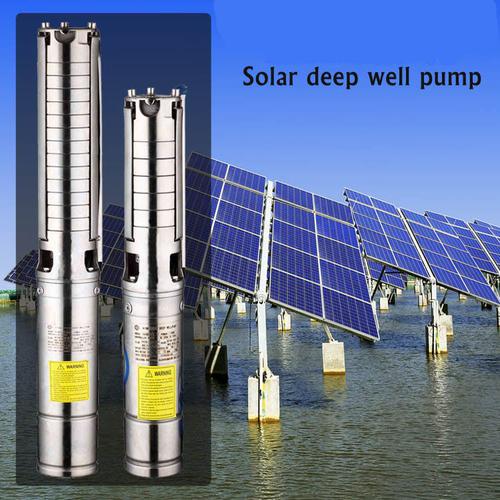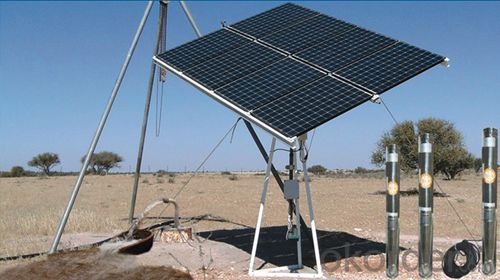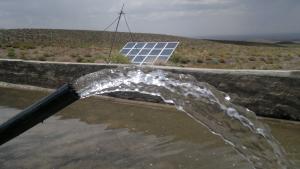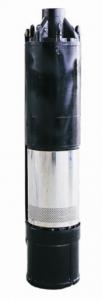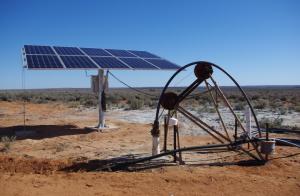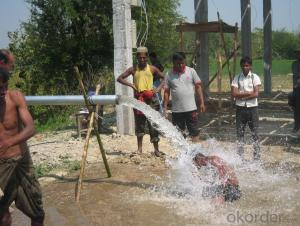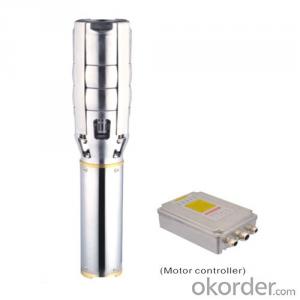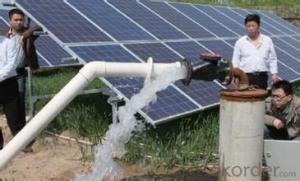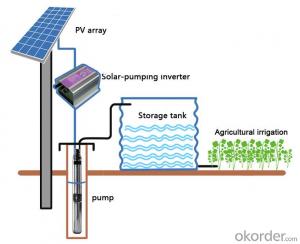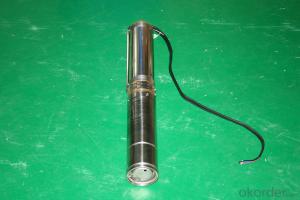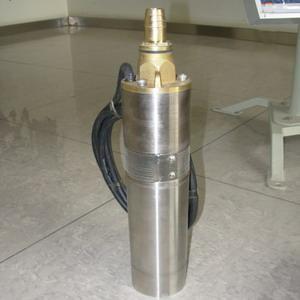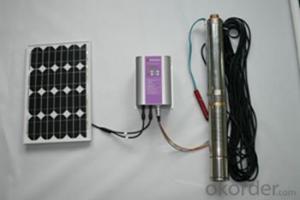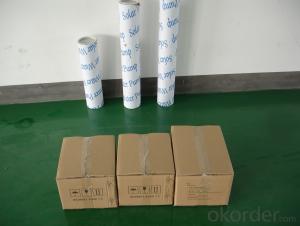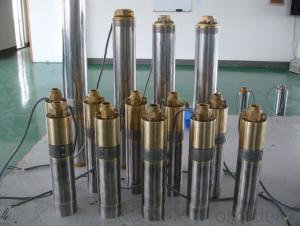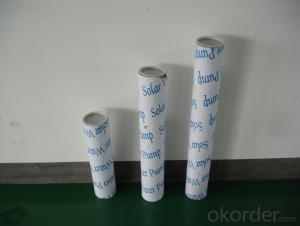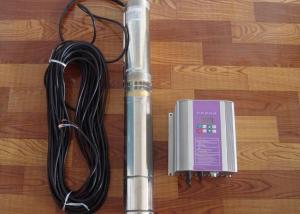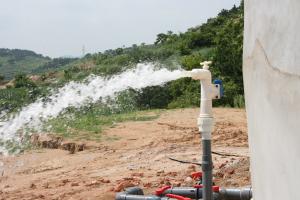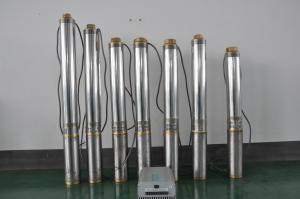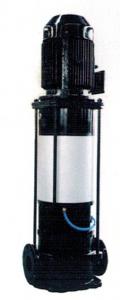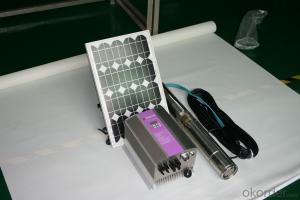Bird Bath Solar Submersible Water Pumps
- Loading Port:
- Shanghai
- Payment Terms:
- TT OR LC
- Min Order Qty:
- 1 set
- Supply Capability:
- 1000 set/month
OKorder Service Pledge
OKorder Financial Service
You Might Also Like
Solar Submersible Pumps Solar Water Pumps
DC solar water pumping system consists of the motor, pump, controller, solar array and some other accessories, such as water level sensor, float switch, etc. Considered that storing water is more efficient than storing electricity, the system is designed to directly drive the pump without battery which can reduce the construction and operating cost and routine maintenance effectively.The PV array consists of multiple solar panels connected in series/parallel, which can supply the whole system as power source by converting the absorbed solar radiation energy to the electrical energy. The pump driven by a brushless DC permanent magnet motor draws water from deep-well or river. The pumped water is then fed into reservoir or water tank, or connected to the irrigation system or fountain system directly.
Advanced Technology
Applications Innovation
The efficiency of DC brushless permanent magnet motor has been increased up to 25% in comparison with traditional asynchronous motor.
Technology Innovation
Stator and rotor are sealed by environment friendly casting resin.Motor insulation resistance can be hold higher than 300MΩfor more than 10 years, which consumedly increased the security and reliability of the submersible motor.
Structure Innovation
Casting resign technology processed stator and rotor as well as the water lubricated bearing make the submersible pump environment friendly.
Feature
High Efficiency & High Reliability
DC Brushless Permanent Magnet Motor
Minimum Maintenance, long Service Life
Environment Friendly Materials, Lubricated Without Oil
Application
Village or Family Water Supply
Animal Drinking Water & Livestock Watering
Garden/Courtyard Irrigation
Swimming Pool
Water Supply for Bivouac or Camping Car
Water Supply for Remote Area
Automatic Control
Operate Automatically, No Need Watching
Maximum Power Point Tracking (MPPT)
Dry-run Protection
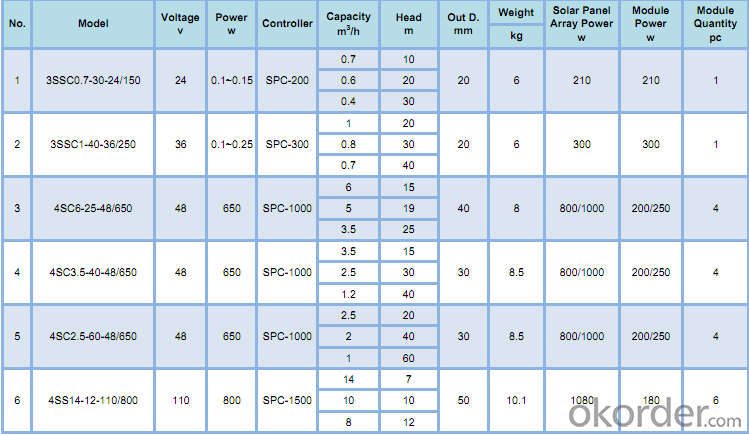
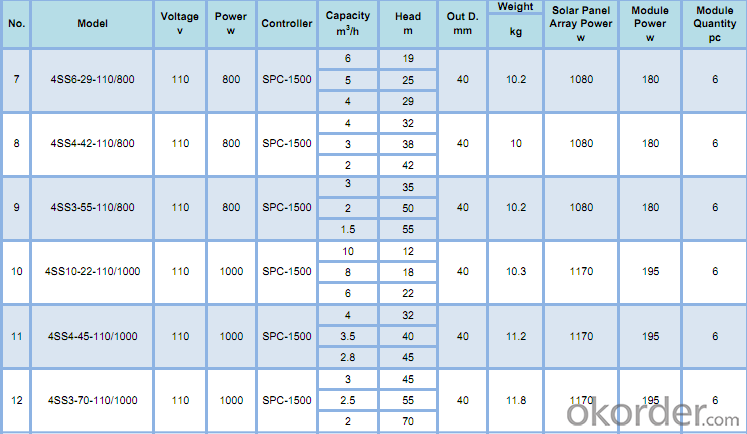
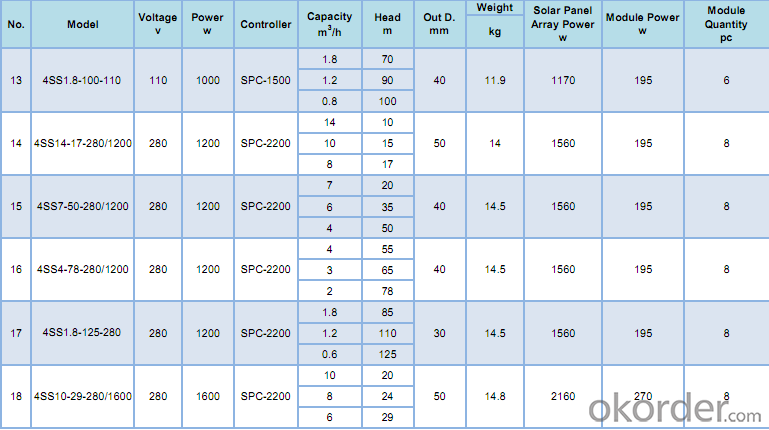
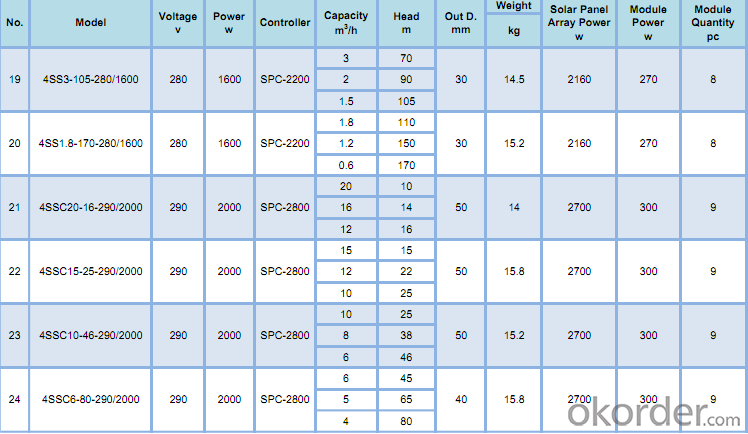
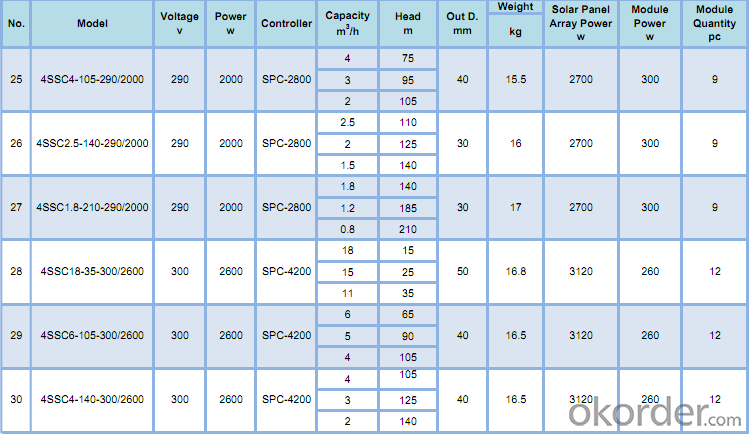
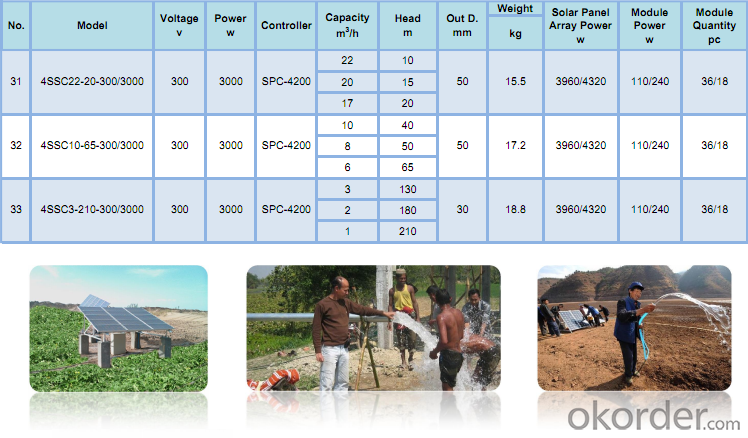
- Q: Can a solar pump be used in areas with high evaporation rates?
- Yes, a solar pump can be used in areas with high evaporation rates. Solar pumps are designed to utilize solar energy to power water pumping systems, and their efficiency is not affected by high evaporation rates. However, it is important to consider the water availability and replenishment in such areas to ensure the sustainable operation of the solar pump system.
- Q: How does the exposure to shade or obstructions affect the performance of a solar pump?
- The exposure to shade or obstructions significantly affects the performance of a solar pump. Shade or obstructions can reduce the amount of sunlight reaching the solar panels, resulting in reduced power generation. This decrease in power output directly impacts the efficiency and effectiveness of the solar pump, leading to decreased water pumping capacity. Therefore, it is crucial to ensure that solar panels are placed in areas with maximum exposure to sunlight to optimize the performance of the solar pump.
- Q: Can a solar pump be used in areas with high levels of nitrates in the water?
- Yes, a solar pump can be used in areas with high levels of nitrates in the water. The solar pump's functionality is independent of the water quality and is primarily dependent on the availability of sunlight to generate power. However, it is important to note that the high levels of nitrates in the water may pose risks to human health, agricultural practices, and the environment, which should be addressed separately.
- Q: Can a solar pump be used in areas prone to flooding?
- Certainly, areas that are prone to flooding can utilize a solar pump. These pumps are specifically engineered to endure various environmental challenges, such as flooding, due to their weather-resistant design. They are often constructed using waterproof and corrosion-resistant materials, enabling them to remain fully operational even in the face of heavy rainfall or flooding. Moreover, solar pumps are not reliant on electricity grids, which renders them a dependable source of water supply during emergencies or natural calamities. Nevertheless, it is crucial to place the solar panels in elevated locations to safeguard against flood-related damage and uphold their efficiency.
- Q: Can a solar pump be used in areas with limited access to local dealers or distributors?
- Yes, a solar pump can be used in areas with limited access to local dealers or distributors. Solar pumps are designed to operate independently of the electrical grid, utilizing solar energy to power the pump. As long as there is ample sunlight available, a solar pump can be installed and used effectively in remote locations without the need for local dealers or distributors.
- Q: Can a solar pump be used for water supply in off-grid fish farms?
- Yes, a solar pump can be used for water supply in off-grid fish farms. Solar pumps are an excellent and sustainable solution for providing water to fish farms located in remote areas where grid electricity is not available. These pumps are powered by solar energy, meaning they do not require any external power source or fuel, making them cost-effective and environmentally friendly. Solar pumps can be used to extract water from a water source such as a river, lake, or borehole, and deliver it to the fish ponds or tanks. They can be designed to provide a constant flow of water, ensuring that the fish have an adequate supply for their growth and well-being. The use of solar pumps in off-grid fish farms offers several advantages. Firstly, it reduces the dependence on fossil fuels and grid electricity, which can be expensive and unreliable in remote locations. Solar pumps are powered by sunlight, which is renewable and abundant, making it a sustainable solution for long-term water supply. Additionally, solar pumps require minimal maintenance as they have fewer moving parts compared to traditional pumps. This reduces the risk of mechanical failures and the need for frequent repairs, resulting in lower operational costs and increased efficiency. Moreover, solar pumps can be easily integrated into existing fish farm infrastructure without significant modifications. They are available in various sizes and capacities, allowing for customization based on the specific water requirements of the fish farm. In conclusion, a solar pump can indeed be used for water supply in off-grid fish farms. It provides a reliable, cost-effective, and environmentally friendly solution for ensuring a continuous and sustainable water supply to support the growth and health of fish in remote locations.
- Q: How long does it take to recharge the batteries in a solar pump system?
- The time it takes to recharge the batteries in a solar pump system depends on various factors such as the size and capacity of the batteries, the amount of sunlight available, and the efficiency of the solar panels. Typically, it can take anywhere from a few hours to a full day to fully recharge the batteries in a solar pump system.
- Q: Are there any specific requirements for the solar panel installation of a solar pump?
- The installation of a solar pump requires specific requirements. Consider the following factors: 1. Capacity of the solar panels: To power the solar pump, the solar panel system needs sufficient capacity. This depends on factors like the pump's power requirements, daily water demand, and solar irradiation levels in the location. Accurate calculations are crucial to ensure optimal performance. 2. Orientation and tilt: For maximum sunlight exposure, install the solar panels in a location that receives sunlight throughout the day. Ideally, they should face south (in the Northern Hemisphere) or north (in the Southern Hemisphere) to capture the most sunlight. The tilt angle should also be set based on the geographical latitude to optimize energy production. 3. Shading: Avoid any shading on the solar panels as it significantly reduces efficiency. Prior to installation, assess the surrounding environment for potential shading sources like trees, buildings, or structures. Position the panels where there is minimal shading. 4. Mounting structure: To withstand environmental conditions, securely mount the solar panels. Depending on the installation location, choose the appropriate mounting structure such as roof-mounted, ground-mounted, or pole-mounted systems. The structure should allow proper ventilation and maintenance access. 5. Wiring and electrical connections: Ensure the wiring for the solar panels can handle the electrical load and minimize energy losses. Follow local electrical codes and safety guidelines during installation. Proper grounding and connection to the solar pump system are essential for safe and efficient operation. 6. Maintenance and monitoring: Regular maintenance is necessary for optimal performance and longevity of the solar panels. This includes cleaning them from dust, dirt, or debris and inspecting for any damage. Installing monitoring systems can help track energy generation and promptly diagnose potential issues. Consulting a qualified solar installer or engineer is important to determine the specific requirements for the solar panel installation of a solar pump. They can provide expertise tailored to your needs and location.
- Q: Can a solar pump be used for water supply in off-grid cabins or remote cottages?
- Yes, a solar pump can be used for water supply in off-grid cabins or remote cottages. Solar pumps are a sustainable and cost-effective solution for these remote locations where access to conventional power sources may be limited. By harnessing energy from the sun, solar pumps can draw water from wells or other water sources and provide a reliable water supply for daily needs such as drinking, cleaning, and irrigation.
- Q: How does the efficiency of a solar pump compare to traditional electric pumps?
- Solar pumps are generally considered to be more efficient than traditional electric pumps. They work by utilizing photovoltaic (PV) panels to convert sunlight into electricity, which then powers the pump. This renewable energy source eliminates the need for grid electricity, resulting in reduced operating costs and a smaller environmental footprint. One significant advantage of solar pumps is their ability to function independently of the power grid, making them suitable for remote and off-grid locations. Unlike traditional electric pumps, which rely on a constant supply of grid electricity that can sometimes be unreliable in certain areas, solar pumps provide a consistent and reliable water supply, especially in regions with ample sunlight. In addition, solar pumps have a longer lifespan and require less maintenance compared to traditional electric pumps. The absence of fuel or moving parts in solar pumps reduces the risk of breakdowns and eliminates the need for regular servicing. Consequently, this leads to lower maintenance costs and increased reliability, making solar pumps a cost-effective long-term investment. Moreover, solar pumps are environmentally friendly as they produce zero greenhouse gas emissions during operation. In contrast, traditional electric pumps rely on electricity generated from fossil fuels, contributing to carbon emissions and pollution. By harnessing the power of the sun, solar pumps promote sustainable and clean energy solutions. Although solar pumps are generally more efficient, their performance can vary depending on factors such as sunlight availability, pump size, and water demand. It is crucial to properly size and design a solar pump system to meet the specific requirements of the application in order to achieve optimal efficiency. In conclusion, solar pumps are generally more efficient than traditional electric pumps. They offer a range of benefits, including independence from the power grid, cost savings, reduced maintenance, and environmentally friendly operation.
Send your message to us
Bird Bath Solar Submersible Water Pumps
- Loading Port:
- Shanghai
- Payment Terms:
- TT OR LC
- Min Order Qty:
- 1 set
- Supply Capability:
- 1000 set/month
OKorder Service Pledge
OKorder Financial Service
Similar products
Hot products
Hot Searches
Related keywords


